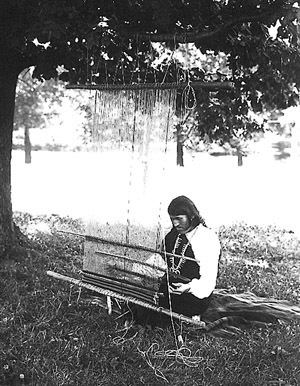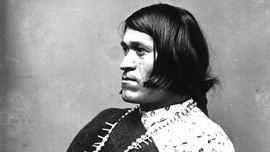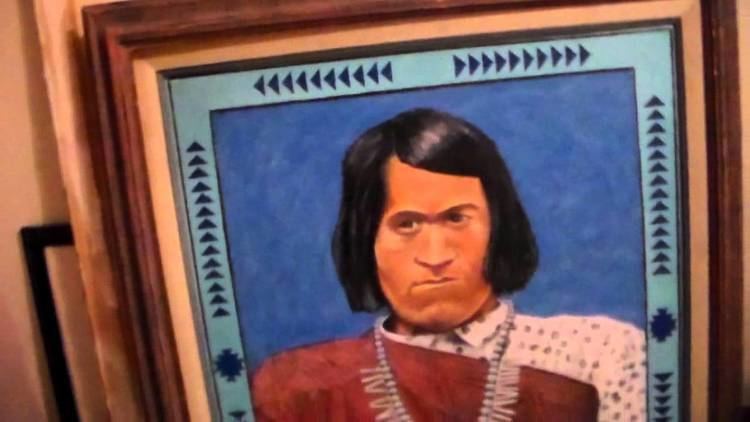 | ||
Died 1896, New Mexico, United States Similar Michael Dillon, Alan L Hart, Christine Jorgensen | ||
Helium histories we wha
We'wha (1849–1896, various spellings) was a Zuni Native American from New Mexico. She was the most famous lhamana, a traditional Zuni gender role, now described as mixed-gender or Two-Spirit. Lhamana were male-bodied but performed primarily feminine tasks, wearing a mixture of women's and men's clothing and doing a great deal of women's work as well as serving as mediators.
Contents

We'wha is the subject of the book The Zuni Man-Woman by Will Roscoe. The anthropologist Matilda Coxe Stevenson also wrote a great deal about We'wha, and even hosted her on their visit to Washington D.C. in 1886. During that visit, We'wha met President Grover Cleveland and was generally mistaken for a cisgender woman. One of the anthropologists close to her described We'wha as "the strongest character and the most intelligent of the Zuni tribe" (Roscoe, 1991, p. 29). She is historically known mainly for transgender identity. In the nineteenth century this status was called berdache, being anatomically one sex but performing tasks that were equated with the other (Roscoe, 1991, pg.29). During her lifetime, she came in contact with many white settlers, teachers, soldiers, missionaries, and anthropologists. One anthropologist she met was Matilda Coxe Stevenson, who would later become a prominent figure in We'wha's life. Stevenson wrote down her observations of We'wha, going on to state, "She performs masculine religious and judicial functions at the same time that she performs feminine duties, tending to laundry and the garden" (Suzanne Bost, 2003, pg.139).

Early life

We'wha was born in 1849 in New Mexico as a member of the Zuni tribe. The Zuni tribe was free to practice their religious customs and ceremonies. They were enemies of the Navajos and Apaches, and often carried out wars against them (Roscoe, 1991, p. 29). The year of We'wha's birth was the first year the Zuni had interactions with the Americans and agreed to help the new colonists fight wars against the Navajo and Apaches for land. The Americans brought smallpox to the village and in 1853 both of We'wha's parents died from the illness (Roscoe, 1991, p. 30) She and her brother were then adopted by their aunt on their father's side. We'wha got to remain a member of her mother's tribal clan known as the donashi:kwe also called the Badger People. She also retained ceremonial ties to her father's clan, bichi:kwe, or The Dogwood People. The new adoptive arrangement also added two foster sisters and a brother (Roscoe, 1991, p. 31).

Zuni men and women could be recognized as berdache, from as early as three or four. In We'wha's case she was seen playing with other girls more often than other boys. Girls would call their other brothers and sisters hanni and the boys would use the word suwe. We'Wha may have used the word hanni which was a word reserved for young girls (Roscoe, 1991, p. 33). We'wha may have also dressed differently than the other boys, not wearing trousers, instead wearing a long shirt that hung down like a dress. This was the typical outfit reserved for young Zuni girls. We'wha however was first indoctrinated into religious ceremonies for Zuni boys at twelve. A few years later the tribe recognized We'wha's lhamana traits and her religious training was then handed over to female relatives. She then learned the skills of the Zuni woman, grinding and making corn meal, making ceremonial pottery, cooking, and various domestic tasks (Roscoe, 1991, p. 38). In 1864 the Zunis and the American troops won a victory over the Navajo, and the Navajo were then sent out to a reservation in New Mexico for four years. Some members of We'wha's tribe then moved into the abandoned Zuni lands of Nutria and Pescado, and became farmers including We'wha and her adopted family (Roscoe, 1991, p. 40). There We'wha held the occupation of farmer, meaning that she was doing a male occupation while her family lived in this area.
Adult life
In the 1870s We'wha was feeling at home with her adoptive family on the new farm. As her adoptive mother began to get older, We'wha took on more of the household duties with her adopted older sister. In 1877 Protestant missionaries began to arrive among the Zuni tribe. These missionaries were part of the "Peace Policy of Grant Administration" (Roscoe, 1991, p. 42). The idea was that Native Americans, instead of being moved into reservationsm should be assimilated into American society by conversion to Christianity. These Protestant missionaries were the first white people to live among their particular Zuni tribe and were likely the first white people that We'wha had encountered. At this point We'wha would have been in her thirties.

The Presbyterian Minister and medical doctor assigned to We'wha's tribe was a man named Taylor F. Ealy. He came to the village with his wife, two daughters, and an assistant teacher on October 12, 1878. They were assigned to a school built there the year before (Roscoe, 1991, p. 43). We'wha helped Mrs. Ealy care for her two small daughters, various teaching responsibilities, and housework. Mrs. Ealy's diary included pages talking about We'wha: "We made in all this week five garments; a skirt and two basques for We-Wa, a dress for Grace (a Zuni), a dress and skirt for her sister, besides one for which they found the calico." That diary entry is dated January 29, 1881 (Bender, 1984, p. 153). It is possible We'wha received payment for her work with the Ealys. It would not have been in the form of currency, rather goods similar to the clothes they made together. There is also evidence that We'wha may have served as a matron in the dormitories of the mission school. She would also have had the responsibility of kitchen maintenance, laundries, and teaching young girls domestic skills (Roscoe, 1991, p. 44). In 1881 the Protestant missionaries began to depart the village including the Ealy family. The mission had changed the religious mindset of the Zuni very little and the impact the school had was minimal. The school remained there but had little impact until it was revitalized in 1888 (Roscoe, 1991, p. 46).
We'wha's and Matilda's friendship
Matilda Coxe Stevenson and We'wha met each other in 1879, while she was working with Mrs. Ealy. Stevenson claims that We'wha was very friendly to outsiders and willing to learn English. She was described by Stevenson as being "the most intelligent person in the pueblo. Strong character made his word law among both men and women with whom she associated. Though his wrath was dreaded by men as well as women, he was loved by all children, to whom he was ever kind" (Stevenson, 2010, p. 37). By learning English, We'wha was able to interact well with other white visitors, and this helped her build a friendship with Mrs. Stevenson. We'wha was visited by Stevenson in 1881, 1884, 1886, 1891–92, 1895 and 1896–97 (Roscoe, 1991, p. 46). These visits encouraged the cultivation of their friendship.
Stevenson in 1879, introduced soap to We'wha's village. She taught them how to wash clothes using soap and soon We'wha began washing clothes for the members of the Protestant mission, earning silver dollars for her service. We'wha then decided to move to Fort Wingate and wash for the soldiers as well as the captain’s family. She began to extend her services past the fort, and wash for white settlers as well. Few Zuni men and women worked for white people for pay. If they did work for pay, "the men wearing female attire being preferred to the women on account of their strength and endurance" (Stevenson, 2012, p. 380).
Stevenson did not discover We'wha's biological sex for many years. She claims that We'wha's sex was so well hidden that she had no knowledge that she was assigned male at birth. It is concluded that in 1886, when they traveled with Stevenson to Washington DC, she still did not know We'wha's assignation at birth, and they lived with each for six months (Roscoe, 1991, pg.48-49). In Washington, We'wha was introduced as an "Indian Princess", and receptions were held in her honor. People who met We'wha assumed she was a cisgender woman. On June 23, 1886, We'wha shook hands with President Grover Cleveland, who also assumed she was a cisgender woman.
It is not known exactly when Stevenson found out We'wha had not been assigned female at birth. It is known it was sometime after 1904, and Stevenson continued to refer to We'wha in her diary as "she". She explains, "As the writer could never think of her faithful and devoted friend in any other light, she will continue to use the feminine gender when referring to We'wha" (Stevenson, 2010, p. 310).
We'wha was hired by Stevenson to make Zuni religious pottery that would later be displayed in the National Museum in Washington DC. We'wha was a very accomplished potter, and followed the strict religious protocols that went with making Zuni pottery. She was also an accomplished weaver, weaving baskets, dresses, blankets, and sashes. It was said that she had an eye for likable patterns and colors. George Wharton James, an expert on Native American weaving styles claims, “She was an expert weaver, and her pole of soft stuff was laden with the work of her loom-blankets and dresses exquisitely woven, and with a delicate perception of colour-values that delighted the eye of the connoisseur" (James, 1920).
Later life
After We'wha returned to their pueblo, conflicts broke out between the Zuni and the U.S. government. We'wha was arrested along with five other Zuni leaders, accused of witchcraft, and served a month in prison. In 1896, at the age of 47, We'wha died from heart failure, while participating in the annual Sha'lako festival.
